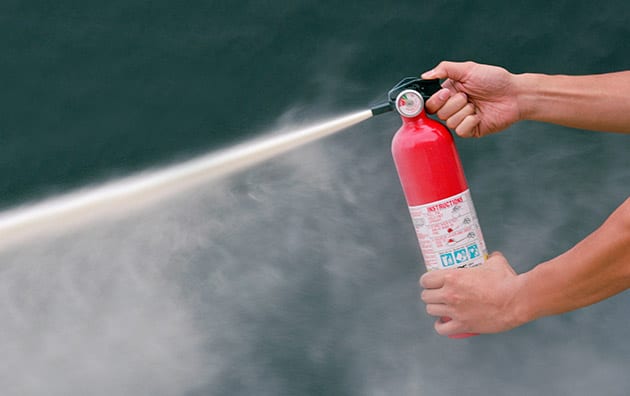Peoria’s tech time presentation at a recent GSL meeting featured retired firefighter Al Devlin giving a short presentation on the proper and effective use of fire extinguishers.

“Fire extinguishers?” you ask. Indeed. It proved a very educational presentation.
Devlin talked about the four types of fire. Type A – wood, paper, and anything that leaves an ash. Type B fires involve flammable liquids. Type C fires involve electricity. And Type D fires are considered “special” – flammable or burning solids like magnesium, for example.
The water fire extinguishers are exclusively for Type A fires. Typically they contain about 2 1/2 gallons of water. Water, of course, doesn’t play well with electricity and spraying water on a burning liquid like grease will simply spread the fire.
CO2 extinguishers do a great job on electrical fires, smothering the fire without destroying electronics. In a pinch, you can use these extinguishers on Type A or B fires, however when the CO2 dissipates, the fire can flash back very quickly.
The “dry chem” ABC extinguishers will put out A, B and C fires. They do, however, leave a very fine powder that’s corrosive to electronics – and it’s not real healthy to breathe either.
Regardless of the extinguisher type, use the “PASS system” for putting out fires. “Pull” the pin, aim, squeeze the handle and sweep the product back and forth across the base or seat of the fire.
 Aim for the base of the fire, not the flames.
Aim for the base of the fire, not the flames.
You can put out a lot of fire with a small extinguisher if you know what you’re doing. Use short bursts and sweep across the seat of the fire from 10 feet away (except for CO2 extinguishers which you should start at 5’ or closer).
At least once a year – or when you change your clocks – you should check your fire extinguishers in addition to replacing smoke detector batteries.
Visually inspect them to see the pressure is in the “green zone” on the dial, that the hose is serviceable and there is no corrosion on the pressurized cylinder. Additionally, you must “fluff” the dry chemical inside the extinguisher by turning the device upside down and listening for the powder inside to shift. If you don’t hear anything, use a rubber mallet to coax the powder to break loose. Over time, the dry chemical agent becomes hard inside these units and it won’t discharge in an emergency.
Furthermore, for those who have extinguishers on vehicles, you should “fluff” those monthly, according to Devlin. The vibrations from driving cause the agent inside to settle and compact very quickly. Furthermore, if you need to use a vehicle mounted unit, turn it upside down a couple of times and shake it before spraying.
Al offered a couple of other tips, too.
First, make sure everyone’s out of the dwelling and someone’s calling the fire department before attempting to use a fire extinguisher.
Also, never let the fire get between you and your exit.
Always back away from a fire that you think is out, just in case it reflashes. If it does reignite, you can react more quickly to attack it again.
And once the professionals arrive, lay the partially discharged unit down in an out-of-the-way location. The pressurized cylinders can become dangerous metal missiles if the spray valves get broken off. And many of the “affordable” big box store units have plastic valve assemblies more prone to breaking.
Even if you successfully put out a fire with one of these units, call the fire department. They’ll make sure the fire really is out, and they’ll provide a fire report necessary for an insurance claim.

Good things to know especially this time of year when fires are more frequent (it seems) with Christmas decorations possibly overloading electric circuits and candles lit. Be safe and have a merry Christmas to all GSL staff and readers.